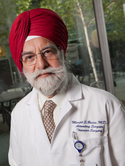| Abstract: |
Purpose: To evaluate the role of postchemotherapy surgery in patients with nonseminomatous germ cell tumors arising from the anterior mediastinum. Patients and Methods: Thirty-two patients with nonseminoma arising from a mediastinal primary site were treated on a clinical trial at our center, and they underwent postchemotherapy surgery. The results of postchemotherapy surgical resection, frequency of viable tumor found during postchemotherapy surgery, and prognostic factors for survival were assessed. Results: Complete resection of all gross residual dis ease was achieved in 27 patients (84%). Histologic analysis of resected residua postchemotherapy revealed viable tumor in 66%, teratoma in 22%, and necrosis in 12% of the specimens. Viable tumor included embryonal carcinoma, choriocarcinoma, yolk sac carcinoma, seminoma, and teratoma with malignant transformation to nongerm cell histology (eg, sarcoma). Clinical characteristics associated with a shorter survival after surgery included the presence of viable tumor in a resected specimen (P = .003) and more than one site resected during surgery (P = .06). There were no statistically significant differences in survival for patients who underwent surgical resection with normal markers compared with patients with elevated serum tumor markers (P = .33). A trend toward shorter survival was found in patients with increasing tumor markers before surgery compared with patients with normal and declining serum tumor markers (P = .09). Conclusion: Surgical resection of residual mass after chemotherapy plays an integral role in the management of patients with primary mediastinal nonseminoma. Teratoma and viable tumor were found in the majority of resected residua after chemotherapy. Because patients who undergo conventional salvage che motherapy programs rarely achieve long-term disease-free status, selected patients with elevated markers after chemotherapy are considered candidates for surgical resection. (C) 2001 by American Society of Clinical Oncology. |








